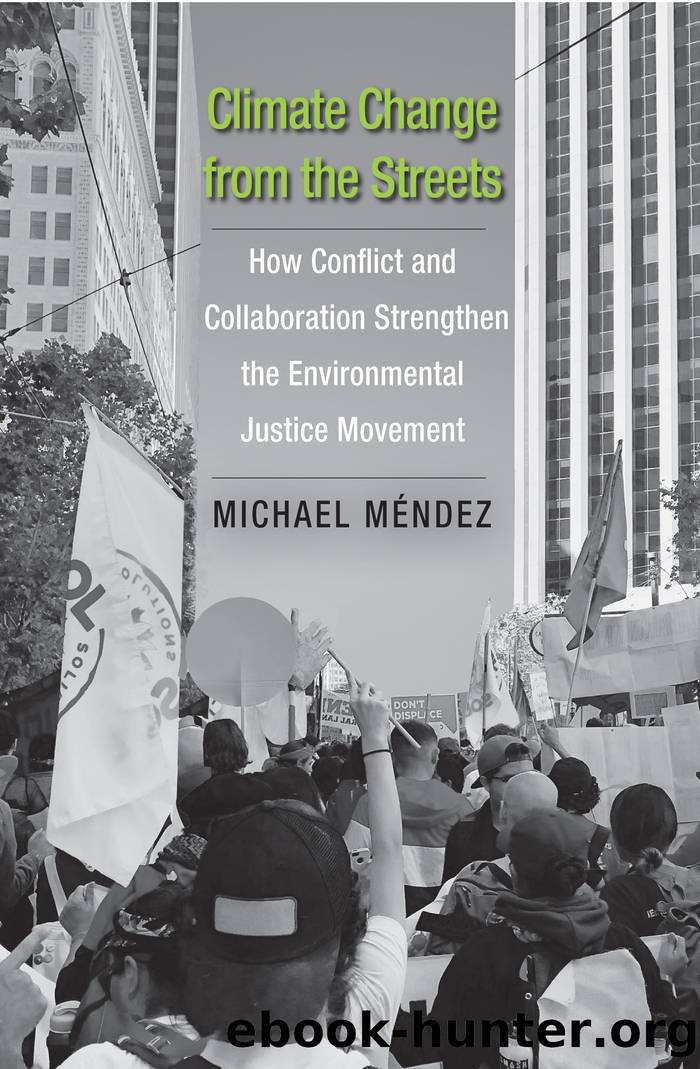Climate Change from the Streets by Michael Mendez

Author:Michael Mendez
Language: eng
Format: epub
Publisher: Yale University Press
Published: 2019-03-15T00:00:00+00:00
Figure 5.1a. SB 535 priority funding fact sheet. Courtesy of the California Climate Equity Coalition (formerly the SB 535 Coalition)
Figure 5.1b. SB 535 priority funding fact sheet. Courtesy of the California Climate Equity Coalition (formerly the SB 535 Coalition)
After months of lobbying and presentations of studies linking housing displacement and increased greenhouse gas emissions, the SB 535 Coalition persuaded the board, the Department of Finance, and the governorâs office that investing in affordable housing near transit was an effective climate mitigation strategy. In May 2013, the board released its first investment plan for cap-and-trade revenue for legislative review and approval. The plan provided guidelines for prioritizing investments that would achieve greenhouse gas reduction goals and yield valuable co-benefits at the statewide scale and, most importantly, in disadvantaged communities. Through a process of engagement, experimentation, and scaling up, environmental justice groups gained practical authority and recognition from regulators for many of their proposed climate solutions, thus transforming ideals once seen as impractical into feasible measures.65
In the first year of SB 535 implementation, California invested nearly $300 million for greenhouse gas mitigation projects benefiting disadvantaged communities. These projects included urban forestry, low-carbon transportation, transit operations and affordable housing, energy efficiency programs, and waste diversion. The SB 535 Coalition worked closely with regulators to clarify criteria and processes for determining which projects to consider under SB 535 and for the defining of co-benefits. Due in large part to the coalitionâs efforts, the boardâs guidance memo for agencies administering investments emphasized projects that spurred local green-collar jobs and improved public healthâin particular by addressing asthma and obesity.66
With the adoption of SB 535 and the cap-and-trade investment plan, the concept of a climate fund had come full circle. Although Californiaâs cap-and-trade program still remains highly controversial with many environmental justice groups, the SB 535 Coalition deepened the stateâs commitment to disadvantaged communities by making environmental justice central to climate change policies and investments. Mari Rose Taruc later described how, with the passage of SB 535, the Asian Pacific Environmental Networkâs work on state-level climate policy âhas to come back to Richmond and Oakland. . . . We have to be able to see those benefits come back to the communities we are working in.â The climate fund provides community-driven opportunities to link Californiaâs climate change policies with efforts to improve air quality, public health, and local economies.67 In contrast to the top-down approach initially taken in the AB 32 scoping plan, SB 535 represents an experiment that challenged institutional practices and created new, multipurpose solutions. Those collaborative solutions, in turn, may help Californiaâs climate change programs begin to address inequities at multiple scales.
Rescaling Climate Change Policy and Decision-Making
The adoption of Californiaâs Climate Change Community Benefits Fund illustrates how and why particular governments link global climate change with equity and local health. A crucial component of those linkages was the capacity of environmental justice groups to develop their practical authority. Advocates such as the Asian Pacific Environmental Networkâs Mari Rose Taruc and Emily Kirsch of the
Download
This site does not store any files on its server. We only index and link to content provided by other sites. Please contact the content providers to delete copyright contents if any and email us, we'll remove relevant links or contents immediately.
The Secret History by Donna Tartt(16627)
The Social Justice Warrior Handbook by Lisa De Pasquale(11489)
Thirteen Reasons Why by Jay Asher(7788)
This Is How You Lose Her by Junot Diaz(5774)
Weapons of Math Destruction by Cathy O'Neil(5038)
Zero to One by Peter Thiel(4824)
The Myth of the Strong Leader by Archie Brown(4789)
Promise Me, Dad by Joe Biden(4449)
Beartown by Fredrik Backman(4419)
Stone's Rules by Roger Stone(4416)
How Democracies Die by Steven Levitsky & Daniel Ziblatt(4399)
The Fire Next Time by James Baldwin(4343)
100 Deadly Skills by Clint Emerson(4079)
A Higher Loyalty: Truth, Lies, and Leadership by James Comey(4033)
Rise and Kill First by Ronen Bergman(4012)
The David Icke Guide to the Global Conspiracy (and how to end it) by David Icke(3883)
The Farm by Tom Rob Smith(3872)
Secrecy World by Jake Bernstein(3783)
The Doomsday Machine by Daniel Ellsberg(3731)
